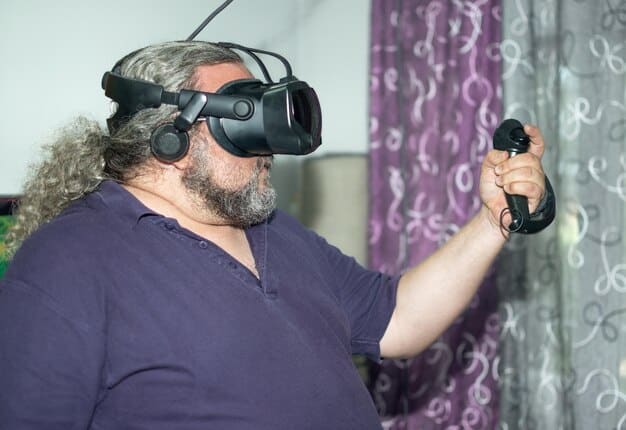VR Accessibility: Ensuring Inclusive VR Applications for US Employees

VR accessibility ensures virtual reality applications are inclusive for all US employees by addressing visual, auditory, motor, and cognitive impairments, promoting equal access through features like adjustable settings, alternative input methods, and clear, customizable interfaces.
Virtual reality (VR) is rapidly transforming various aspects of the workplace, and it’s crucial that these advancements are accessible to everyone. **VR accessibility: ensuring your VR applications are inclusive for all US employees** means creating environments and experiences that cater to individuals with disabilities, fostering a more equitable and productive work environment.
Why VR Accessibility Matters for US Businesses
VR technology holds immense potential for training, collaboration, and innovation within businesses across the United States. However, without proper accessibility considerations, VR applications can inadvertently exclude a significant portion of the workforce. Ensuring VR is accessible isn’t just about compliance; it’s about unlocking the full potential of every employee.
Creating inclusive VR experiences is vital for tapping into the diverse talent pool within the US. By removing barriers, businesses can empower individuals with disabilities to participate fully and contribute their unique skills and perspectives.
Legal Compliance and Ethical Considerations
In the US, several laws protect the rights of individuals with disabilities, including the Americans with Disabilities Act (ADA). While the ADA doesn’t specifically address VR, its principles of accessibility and reasonable accommodation extend to digital technologies used in the workplace.
Beyond legal mandates, there’s a strong ethical argument for VR accessibility. Designing for inclusivity demonstrates a commitment to diversity, equity, and inclusion (DEI), which can enhance a company’s reputation and attract top talent.

- ADA Compliance: Understand how the ADA’s principles apply to VR applications in the workplace.
- WCAG Guidelines: Familiarize yourself with the Web Content Accessibility Guidelines (WCAG), which provide a framework for making digital content more accessible.
- Ethical Design: Prioritize inclusivity and accessibility from the outset of the VR application development process.
Implementing VR accessibility initiatives is more than just ticking boxes; it’s about creating a better, more inclusive workplace where everyone can thrive. By removing barriers and promoting inclusivity, businesses can unlock the full potential of their workforce and reap the benefits of a truly diverse and equitable environment.
Understanding Different Disabilities and Their VR Accessibility Needs
To effectively create accessible VR applications, it’s crucial to understand the diverse needs of individuals with various disabilities. This includes visual, auditory, motor, and cognitive impairments. Each type of disability presents unique challenges in the VR environment, requiring tailored accessibility solutions.
By considering these individual needs, developers can design VR experiences that are truly inclusive and empowering for all users.
Visual Impairments
Individuals with visual impairments may experience challenges such as blindness, low vision, color blindness, or sensitivity to light. To address these challenges, VR applications should offer features like:
- Screen Magnification: Allow users to zoom in on specific areas of the VR environment.
- Text-to-Speech Narration: Provide audio descriptions of visual elements and instructions.
- Adjustable Contrast and Colorblind Modes: Enable users to customize the visual appearance of the VR environment to suit their needs.
Auditory Impairments
Individuals with auditory impairments may experience challenges such as hearing loss or deafness. To address these challenges, VR applications should offer features like:
- Captions and Subtitles: Provide text-based representations of audio content, including dialogue and sound effects.
- Visual Cues for Audio Events: Use visual indicators to alert users to important audio events, such as approaching sounds or notifications.
- Adjustable Volume Levels: Allow users to customize the volume of different audio channels.
Motor Impairments
Individuals with motor impairments may experience challenges with movement, dexterity, or coordination. To address these challenges, VR applications should offer features like:

- Alternative Input Methods: Support a variety of input methods, such as voice commands, eye tracking, and adaptive controllers.
- Customizable Control Schemes: Allow users to remap buttons and adjust sensitivity settings.
- Simplified Interactions: Design interactions that require minimal physical effort and precision.
Cognitive Impairments
Individuals with cognitive impairments may experience challenges with memory, attention, or problem-solving. To address these challenges, VR applications should offer features like:
- Clear and Concise Instructions: Provide simple, step-by-step guidance.
- Visual Aids and Prompts: Use visual cues to reinforce instructions and provide reminders.
- Adjustable Difficulty Levels: Allow users to customize the complexity of the VR experience.
By implementing these and other VR accessibility features, businesses can ensure that their VR applications are inclusive and empowering for all employees, regardless of their abilities. This not only fosters a more equitable workplace but also unlocks the diverse talents and perspectives of the entire workforce.
Practical Strategies for Designing Accessible VR Experiences
Creating accessible VR experiences requires a proactive and iterative approach. By incorporating accessibility considerations throughout the design and development process, developers can significantly improve the usability and inclusivity of their VR applications. Here are some practical strategies to guide your efforts:
Prioritizing accessibility from the outset can lead to more innovative and user-friendly VR experiences for everyone involved.
User Research and Testing
Engaging with individuals with disabilities is essential for gaining valuable insights into their needs and challenges. Conduct user research to gather feedback on existing VR applications and identify areas for improvement.
Usability testing with diverse user groups can help uncover potential accessibility barriers and ensure that the VR experience is intuitive and enjoyable for everyone.
Design Principles for Accessibility
Adopt design principles that prioritize accessibility, such as:
- Perceivability: Ensure that all users can perceive the content and interface, regardless of their sensory abilities.
- Operability: Ensure that all users can operate the interface and navigate the VR environment.
- Understandability: Ensure that the content and instructions are clear, concise, and easy to understand.
- Robustness: Ensure that the VR application is compatible with a wide range of assistive technologies.
Leveraging VR Accessibility APIs and Tools
Take advantage of VR accessibility APIs (Application Programming Interfaces) and tools that can simplify the development process and enhance the accessibility of your VR applications.
These tools can provide features such as screen readers, voice commands, and adaptive controllers, making it easier to create inclusive VR experiences.
Iterative Development and Feedback Loops
Embrace an iterative development process that incorporates ongoing feedback from users with disabilities. Regularly test and refine your VR applications based on user feedback to continuously improve their accessibility.
This iterative approach ensures that your VR applications remain inclusive and user-friendly as technology evolves.
The Business Benefits of Investing in VR Accessibility
Investing in VR accessibility is not just a matter of compliance or ethics; it’s a smart business decision. Accessible VR applications can unlock a range of benefits for businesses, including increased productivity, enhanced employee engagement, and a stronger brand reputation.
By embracing accessibility, businesses can create a more inclusive and thriving work environment that benefits everyone.
Expanding the Talent Pool
Accessible VR applications can broaden the talent pool by enabling individuals with disabilities to participate fully in the workplace. This can help businesses attract and retain top talent, regardless of their abilities.
By removing barriers to entry, businesses can tap into a diverse range of skills and perspectives, fostering innovation and creativity.
Improving Employee Engagement
When employees feel included and supported, they are more likely to be engaged and motivated. Accessible VR applications can create a more inclusive work environment, leading to increased employee satisfaction and productivity.
By providing equal access to VR-based training and collaboration tools, businesses can empower all employees to reach their full potential.
Enhancing Training and Development
VR offers powerful opportunities for training and development, allowing employees to practice new skills in a safe and immersive environment. Accessible VR applications can make these training opportunities available to everyone, regardless of their abilities.
By providing customized learning experiences, businesses can improve training outcomes and reduce the risk of workplace accidents.
Promoting a Positive Brand Image
Businesses that prioritize VR accessibility demonstrate a commitment to diversity, equity, and inclusion. This can enhance their brand reputation and attract customers and investors who value social responsibility.
By promoting a positive brand image, businesses can gain a competitive edge in the marketplace and build long-term customer loyalty.
Tools and Resources for Creating Accessible VR Applications
Creating accessible VR applications can be simplified by leveraging various tools and resources designed to support accessibility considerations. These resources range from development platforms with built-in accessibility features to guidelines and best practices for inclusive design.
By utilizing these tools and resources, developers can create VR experiences that are both innovative and accessible to all users.
Unity and Unreal Engine Accessibility Features
Popular game engines like Unity and Unreal Engine offer a range of accessibility features that can be integrated into VR applications. These features include:
- Text-to-Speech APIs: Enable developers to add audio descriptions and narration to their VR environments.
- Input Remapping Tools: Allow users to customize control schemes and input methods.
- UI Scaling and Contrast Settings: Provide options for adjusting the visual appearance of the VR interface.
VR Accessibility Libraries and Plugins
Several VR accessibility libraries and plugins are available to simplify the development process and enhance the accessibility of VR applications. These libraries and plugins provide pre-built components and tools for:
- Screen Magnification: Implement screen magnification capabilities within the VR environment.
- Captioning and Subtitling: Add captions and subtitles to audio content.
- Adaptive Controllers: Support a wide range of adaptive controllers and input devices.
Future Trends in VR Accessibility
VR accessibility is a dynamic field that is constantly evolving. As VR technology advances, new challenges and opportunities will emerge, requiring ongoing innovation and adaptation. By staying informed about future trends, developers can ensure that their VR applications remain inclusive and user-friendly.
By embracing these trends, developers can create VR experiences that are truly transformative and accessible to all users.
AI-Powered Accessibility Solutions
Artificial intelligence (AI) is poised to play a significant role in VR accessibility. AI-powered solutions can automate tasks such as:
- Real-Time Captioning: Automatically generate captions for live audio content.
- Scene Description: Provide audio descriptions of visual elements in the VR environment.
- Adaptive Assistance: Offer personalized assistance and guidance based on user needs.
Brain-Computer Interfaces (BCIs)
Brain-computer interfaces (BCIs) hold the potential to revolutionize VR accessibility by enabling users to control VR applications with their thoughts. This technology could be particularly beneficial for individuals with severe motor impairments.
- Mind-Controlled Navigation: Allow users to navigate the VR environment using brain signals.
- Thought-Activated Interactions: Enable users to interact with objects and menus using their thoughts.
Haptic Feedback Enhancements
Haptic feedback, which involves the use of touch sensations, can enhance the immersiveness and accessibility of VR experiences. Advanced haptic technologies can provide users with a greater sense of presence and allow them to interact with virtual objects in a more natural way.
- Textural Feedback: Simulate the feel of different textures and materials in the VR environment.
- Force Feedback: Provide resistance and force feedback when interacting with virtual objects.
| Key Point | Brief Description |
|---|---|
| ♿ Accessibility Matters | VR accessibility lets everyone join in, regardless of ability. |
| 👂 Auditory Needs | Captions & visual cues for audio are key for inclusive VR. |
| 👁️ Visual Support | Offer zoom, text-to-speech, and customizable color modes. |
| 🤝 Business Benefits | Inclusive VR boosts talent, engagement, and brand image. |
Frequently Asked Questions
▼
VR accessibility refers to designing virtual reality experiences that are usable by people with a wide range of abilities and disabilities, including visual, auditory, motor, and cognitive impairments.
▼
It’s crucial as it allows all employees, regardless of their abilities, to participate fully in training, collaboration, and other VR-based activities. It fosters inclusivity and unlocks a broader talent pool.
▼
Common features include screen magnification, text-to-speech narration, adjustable contrast and colorblind modes, captions, alternative input methods, and customizable control schemes, clear instructions.
▼
Engage users with disabilities in usability testing to gather feedback on their experience. Tools like accessibility audits as well as automated testing that integrates accessibility checks are helpful.
▼
Benefits include an expanded talent pool, improved employee engagement, enhanced training and development capabilities, and a stronger brand image associated with diversity and inclusion.
Conclusion
Ensuring **VR accessibility** is not merely a matter of compliance but a strategic imperative for US businesses. By proactively addressing the needs of individuals with disabilities, organizations can unlock the full potential of VR technology, fostering a more inclusive, productive, and innovative work environment for all. Embracing VR accessibility aligns with ethical considerations, promotes a positive brand image, and expands the talent pool, ultimately contributing to the success and sustainability of businesses in the US.





